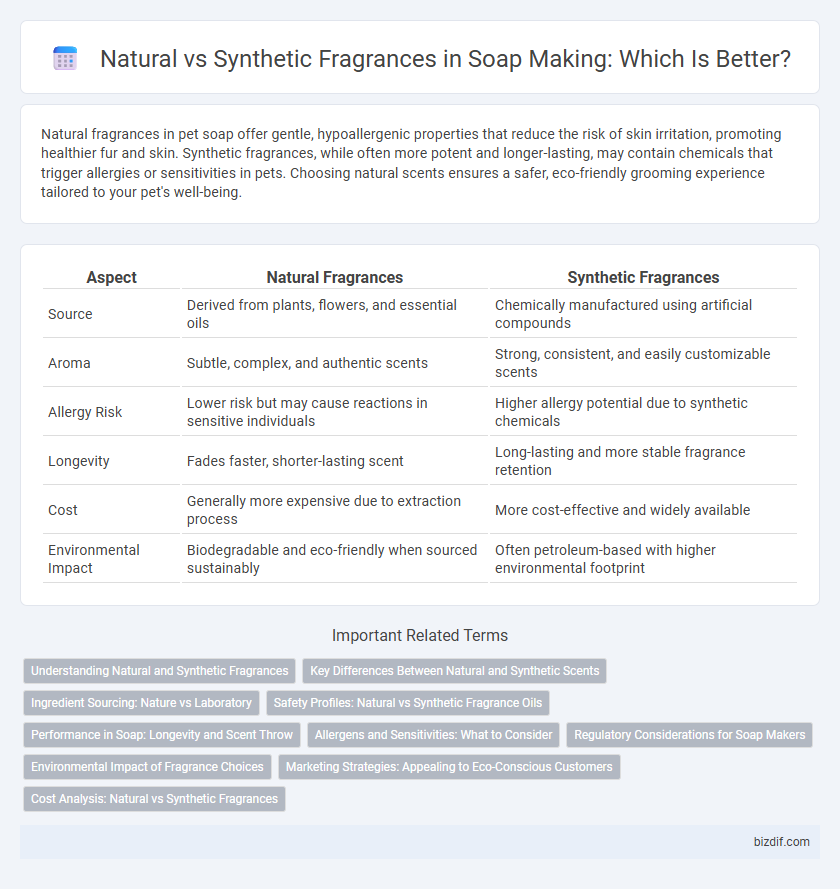Natural fragrances in pet soap offer gentle, hypoallergenic properties that reduce the risk of skin irritation, promoting healthier fur and skin. Synthetic fragrances, while often more potent and longer-lasting, may contain chemicals that trigger allergies or sensitivities in pets. Choosing natural scents ensures a safer, eco-friendly grooming experience tailored to your pet's well-being.
Table of Comparison
| Aspect | Natural Fragrances | Synthetic Fragrances |
|---|---|---|
| Source | Derived from plants, flowers, and essential oils | Chemically manufactured using artificial compounds |
| Aroma | Subtle, complex, and authentic scents | Strong, consistent, and easily customizable scents |
| Allergy Risk | Lower risk but may cause reactions in sensitive individuals | Higher allergy potential due to synthetic chemicals |
| Longevity | Fades faster, shorter-lasting scent | Long-lasting and more stable fragrance retention |
| Cost | Generally more expensive due to extraction process | More cost-effective and widely available |
| Environmental Impact | Biodegradable and eco-friendly when sourced sustainably | Often petroleum-based with higher environmental footprint |
Understanding Natural and Synthetic Fragrances
Natural fragrances in soap making are derived from essential oils, plant extracts, and other organic sources, offering authentic aromas and potential therapeutic benefits. Synthetic fragrances, created through chemical processes, provide a broader range of scent options and consistent scent strength but may contain allergens or irritants. Understanding the differences between natural and synthetic fragrances is crucial for soap makers aiming to balance scent quality, skin sensitivity, and product stability.
Key Differences Between Natural and Synthetic Scents
Natural fragrances in soap making derive from plant-based essential oils and extracts, providing authentic aroma profiles with therapeutic benefits like aromatherapy and skin nourishment. Synthetic fragrances consist of chemically formulated molecules designed to mimic natural scents or create novel aromas, offering greater consistency, variety, and cost-effectiveness. The key differences lie in source composition, with natural scents being biodegradable and potentially allergenic, while synthetic scents offer longer shelf life but may contain phthalates and allergens not found in nature.
Ingredient Sourcing: Nature vs Laboratory
Natural fragrances in soap making are derived from essential oils, plant extracts, and other botanical sources, ensuring a supply rooted in sustainable agriculture and wild harvesting. Synthetic fragrances are formulated through chemical processes in laboratories, offering consistent scent profiles unaffected by seasonal or environmental changes. Ingredient sourcing for natural fragrances emphasizes eco-friendly practices and renewable resources, while synthetic options prioritize controlled production and cost efficiency.
Safety Profiles: Natural vs Synthetic Fragrance Oils
Natural fragrances in soap making typically derive from essential oils and plant extracts, offering safer profiles with lower risks of skin irritation or allergic reactions compared to synthetic fragrance oils. Synthetic fragrances often contain petrochemicals and artificial compounds that can cause sensitization, contact dermatitis, or respiratory issues in sensitive individuals. Choosing natural fragrance oils enhances product safety and supports hypoallergenic formulations, crucial for consumers with sensitive skin.
Performance in Soap: Longevity and Scent Throw
Natural fragrances in soap often provide a subtle, evolving scent with moderate longevity due to their volatile essential oil components, which can dissipate quickly during curing and use. Synthetic fragrances typically offer stronger scent throw and longer-lasting aroma because they contain stable aromatic compounds engineered for enhanced performance in soap formulations. Balancing natural and synthetic elements can optimize both the longevity and scent projection, creating a more consistent fragrance experience in handmade soaps.
Allergens and Sensitivities: What to Consider
Natural fragrances in soap making often contain essential oils with inherent allergens like limonene and linalool, which can trigger sensitivities in some individuals. Synthetic fragrances, although chemically manufactured, can include fewer known allergens but may contain artificial compounds that provoke irritation or allergic reactions. Soap makers must carefully evaluate ingredient labels and consider the target market's skin sensitivity to minimize adverse effects while achieving desired scent profiles.
Regulatory Considerations for Soap Makers
Soap makers must navigate regulatory frameworks such as IFRA standards and EU Cosmetics Regulation when choosing between natural fragrances like essential oils and synthetic fragrance compounds. Natural fragrances often require compliance with allergen labeling and preservation stability, while synthetic fragrances demand adherence to restricted substance lists to avoid harmful ingredients. Understanding these regulations ensures product safety, consumer transparency, and market access within major regions including North America, Europe, and Asia.
Environmental Impact of Fragrance Choices
Natural fragrances in soap making typically derive from essential oils and plant extracts, offering biodegradable and eco-friendly alternatives that reduce chemical pollution. Synthetic fragrances, often composed of petrochemicals, contribute to environmental toxicity and can persist in waterways, negatively impacting aquatic ecosystems. Choosing natural fragrances supports sustainable practices by minimizing harmful residues and promoting safer biodegradation.
Marketing Strategies: Appealing to Eco-Conscious Customers
Natural fragrances in soap making attract eco-conscious customers by emphasizing organic ingredients, sustainability, and non-toxic benefits. Marketing strategies highlight transparency, cruelty-free sourcing, and biodegradability to build trust and brand loyalty. Synthetic fragrances often rely on vibrant scents and lower costs but face growing skepticism from environmentally aware consumers seeking ethical and green products.
Cost Analysis: Natural vs Synthetic Fragrances
Natural fragrances in soap making generally incur higher costs due to the extraction methods from plants and essential oils, which are labor-intensive and yield lower quantities. Synthetic fragrances, produced through chemical synthesis, offer cost-effective alternatives with consistent aroma profiles and longer shelf life. Budget-conscious soap makers often weigh the initial expense of natural fragrances against the affordability and stability of synthetic options when determining formulation costs.
Natural Fragrances vs Synthetic Fragrances Infographic

 bizdif.com
bizdif.com